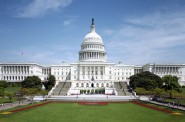Foxconn Could Take Till 2058 To Pay Off
Taxpayers could lose big, depending on number of jobs created, how long company in business.

Foxconn chairman Terry Gou and Governor Scott Walker signing a memorandum of understanding. Photo by Jeramey Jannene.
When the Legislative Fiscal Bureau wrote last week that it would take until at least 2043 for Wisconsin to break even on the Foxconn subsidies, they were summarizing a Department of Administration analysis that used the “best case” assumptions. Using the same methodology and most of the same assumptions, a new Wisconsin Budget Project analysis calculates that other scenarios within the range described by Foxconn could mean that the cost of the state subsidies would not be recovered until 2050 or 2058.
Of course, the DOA analysis and our alternative scenarios all raise the question of whether we can ever expect to break even on the state’s investment and local costs. As many people have pointed out, tech companies aren’t the most stable employers, and Foxconn’s own record illustrates that point. With that in mind, our new analysis calculates how much Wisconsin would be in the hole if Foxconn pulled out of Wisconsin 25 years from now or, alternatively, if they pull out of Wisconsin in 2034 when the annual subsidy payments would end.
Foxconn has said that the new plant it wants to build in southeast Wisconsin could employ between 3,000 and 13,000 workers. In addition to the “best case scenario” of 13,000 new Foxconn jobs, we considered the possibility that they would employ 6,500 workers or 3,000 workers. The following table shows the different assumptions we used for those alternatives, and how alternative assumptions affect the amount of credits received by Foxconn, the annual change in tax revenue, and the length of the breakeven period for the state.
Table 1: Less optimistic assumptions postpone the breakeven date
| Best Case Scenario | Alternative 1 | Alternative 2 | |
| Foxconn jobs | 13,000 | 6,500 | 3,000 |
| Construction period jobs | 16,200 | 16,200 | 16,200 |
| Other “indirect” jobs | 22,000 | 16,500 | 11,000 |
| Total ongoing jobs | 35,000 | 23,000 | 14,000 |
| Cost of tax credits | $2.84 billion | $2.36 billion | $1.73 billion |
| Training funds & local grants | $10 million | $30 million | $30 million |
| New taxes – construction period | $187 million | $187 million | $187 million |
| New taxes – ongoing | $115 million/yr. | $75.3 million/yr. | $46.7 million/yr. |
| New tax growth captured by WI | 100% | 95% | 90% |
| Breakeven year | 2043 | 2050 | 2058 |
Click here to get a view a printable document showing how the state’s breakeven point for the Foxconn incentives could be far longer than 25 years, depending on the assumptions made.
Note that under “alternative 1” we assumed that a 50% reduction in the number of Foxconn workers would result in a 25% reduction in the employment gains resulting from the new economic activity, and for alternative 2 we assumed a 50% reduction in the indirect employment gains. We could have based our analysis on even smaller numbers of new “indirect” jobs by simply assuming that the number of those jobs would be directly proportional to the number of Foxconn jobs. However, our premise is that a plant with fewer workers but more automation would still yield a significant increase in employment within the “supply chain.” Nevertheless, the number of “indirect” jobs would be much lower than assumed in the best case scenario because there wouldn’t be as much new income circulating in the area and that would yield a smaller bump in the employment that stems from the income gains.
We do not claim that there is any particular economic expertise underlying our assumptions. Instead, we are simply engaged in a mathematical exercise to illustrate the key point that projections based on a particular set of assumptions can be far off the mark if those assumptions are incorrect. In other words, we have engaged in an exercise of risk analysis rather than an effort in economic forecasting.
Another one of the challenges for anyone attempting to calculate a breakeven period for a set of business subsidies is the question of how much of the increased economic activity will be in Wisconsin and how much of the resulting increase in tax revenue will be captured outside our state. That’s especially relevant in this instance because the new plant will be very close to the Illinois border, and northern Illinois has a significantly higher unemployment rate than southern Wisconsin.
The DOA analysis assumed that 100% of the new state tax revenue would go into the Wisconsin treasury, which seems unrealistic. Many of the workers at the Foxconn plant will commute from Illinois, and some of the new income they earn will generate sales tax revenue south of the border. In addition, some of the new “indirect” employment that the DOA analysis is counting on will almost certainly be in businesses located in Illinois. As a result, some of the indirect employment that is part of the supply chain will boost Illinois income tax collections rather than Wisconsin’s tax coffers. With that in mind, our alternative scenarios use slightly less optimistic assumptions about how much of the new tax revenue will end up in Wisconsin.
Under alternative 1 we calculate that although the Foxconn subsidies would be lower, it would take until 2050 for increased tax revenue to fully offset the costs. And under alternative 2 – which decreases the number of assumed jobs and assumes that 10% of the growth in tax revenue would end up in the coffers of Illinois or other states – the breakeven point would be in 2058. However, a strong case can be made that the breakeven point under any of the three scenarios would actually be even further in the future since the methodology that we borrowed from the DOA analysis fails to account for the costs to the state of not using the money in question for different sorts of investments.
Considering how quickly television and other flat screen technology has been changing, there’s a significant risk that the proposed Foxconn plant won’t be operating long enough to come close to offsetting the state’s massive investments. Assuming the new plant does not become obsolete even before 2034, that year is when the risk of Foxconn pulling up stakes and going elsewhere is probably greatest because it’s when the state would stop writing them checks for 17% of payroll costs. When a company’s business plan relies on such large subsidies, how confident can we be that they will remain in Wisconsin when those subsidies are gone?
Table 2: Estimate of the unrecovered subsidies if the Foxconn plant closes
| Best Case Scenario | Alternative 1 | Alternative 2 | |
| Foxconn jobs | 13,000 | 6,500 | 3,000 |
| Unrecovered subsidies: | |||
| Foxconn plant closes in 2034 | $922 million | $1.10 billion | $949 million |
| Foxconn plant closes in 2042 | $1.8 million | $530 million | $621 million |
One of the surprising findings of our analysis is that the net loss for Wisconsin taxpayers from Foxconn were to end its Wisconsin operations in 2034 is in the same ballpark regardless of which of the three scenarios one assumes. Table 2 shows our estimates of the net cost to the state under each of the three scenarios if the Foxconn plant is no longer operating in 2034 or if it ceases operations 25 years from now. The difference between those scenarios becomes much clearer in later years, after the state has stopped paying job credits that are directly proportional to the size of the Foxconn payroll.
Our calculations help drive home the point that it may be wishful thinking to believe that the huge subsidies Wisconsin is considering granting to Foxconn would be offset by increased tax revenue by 2043. And our analysis reveals that if the plant closes much before then, Wisconsin won’t come anywhere close to recovering what it spends for the annual checks that will be sent each year to Foxconn.
More about the Foxconn Facility
- Foxconn Acquires 20 More Acres in Mount Pleasant, But For What? - Joe Schulz - Jan 7th, 2025
- Murphy’s Law: What Are Foxconn’s Employees Doing? - Bruce Murphy - Dec 17th, 2024
- With 1,114 Employees, Foxconn Earns $9 Million in Tax Credits - Joe Schulz - Dec 13th, 2024
- Mount Pleasant, Racine in Legal Battle Over Water After Foxconn Failure - Evan Casey - Sep 18th, 2024
- Biden Hails ‘Transformative’ Microsoft Project in Mount Pleasant - Sophie Bolich - May 8th, 2024
- Microsoft’s Wisconsin Data Center Now A $3.3 Billion Project - Jeramey Jannene - May 8th, 2024
- We Energies Will Spend $335 Million on Microsoft Development - Evan Casey - Mar 6th, 2024
- Foxconn Will Get State Subsidy For 2022 - Joe Schulz - Dec 11th, 2023
- Mount Pleasant Approves Microsoft Deal on Foxconn Land - Evan Casey - Nov 28th, 2023
- Mount Pleasant Deal With Microsoft Has No Public Subsidies - Evan Casey - Nov 14th, 2023
Read more about Foxconn Facility here
Wisconsin Budget
-
Charting The Racial Disparities In State’s Prisons
 Nov 28th, 2021 by Tamarine Cornelius
Nov 28th, 2021 by Tamarine Cornelius
-
State’s $1 Billion Tax Cut Leaves Out 49% of Taxpayers
 Sep 21st, 2021 by Tamarine Cornelius
Sep 21st, 2021 by Tamarine Cornelius
-
TANF Program Serves a Fraction of Poor Families
 Aug 30th, 2021 by Jon Peacock
Aug 30th, 2021 by Jon Peacock




















